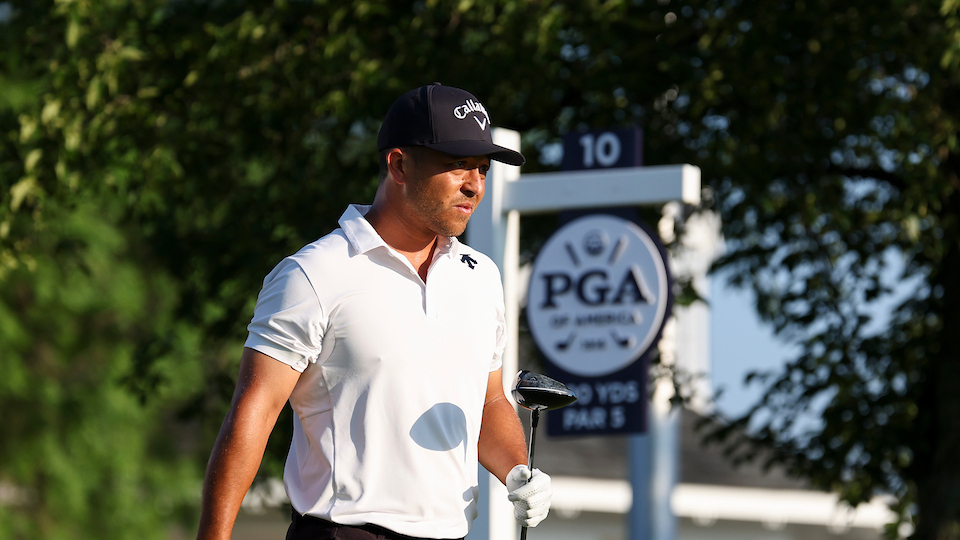In reviewing the 18 holes at Augusta National it's important to remember a crucial decision was wisely implemented following the inaugural event.
The nines were reversed in 1935 and the timing of that decision set the stage for one of the greatest shots not only in Masters history but all of major championship golf.
Gene Sarazen holed his 2nd shot for a double-eagle at the par-5 15th propelling him to victory and thus becoming the charter member of the modern Grand Slam club.
Co-founder Bob Jones and architect Alister MacKenzie each shared a profound love for the Old Course at St Andrews. Augusta National's guiding philosophy was to create an inland version set on the rolling Georgia landscape by embodying the many intricacies and challenges found with that great links in Scotland.
Both Jones and MacKenzie favored wide fairways thereby accommodating varied skill levels able then to navigate alternative ways around the golf course. Augusta National has more than 80 acres of fairway which is nearly double that of most golf facilities. The club also eschewed the heavy-handed insertion of penal high grass around the perimeter used by other notable clubs as a deterrent to wayward play.
"Augusta National provides shots which the greatest of all golfers has the utmost difficulty in carrying out successfully, and yet it has only twenty-two bunkers, no rough, and is a paradise for the average golfer." - Alister MacKenzie
Strategic thinking would be rewarded rather than a traditional embrace of penal architecture where even the slightest of errors are penalized rigorously.
Augusta National's prime defense comes with the complexity of the putting surfaces. Jones and MacKenzie were both enamored with the green complexes at The Old Course.
Although Augusta National does not have the overall size of famed double greens found across the pond, the average square footage of 6,435 can be maddening for players unable to skilfully position approach play throughout the round.
View this post on Instagram
Jones was famous for saying about his beloved Augusta National, "We want to make bogeys easy if frankly sought, pars readily attainable by standard good play... and birdies except on par fives... dearly sought."
The 365-acre site was a former nursery / antebellum plantation called Fruitlands before being turned into a world renowned golf club. Each of the holes on the property is named after a tree or shrub.
Jones, in concert with his co-founder Clifford Roberts, was able to secure $70,000 to pay for the property.
More than just about any golf club, Augusta National has implemented a series of upgrades to the course over the years with a number of various architects having been involved. After each tournament concludes an assessment is made on what next steps may be carried out. Years ago, when asked about the changes co-founder Clifford Roberts sternly rebuked the questioner and said: "Sir, we do not change Augusta, we improve it."
When Tiger Woods won his first Masters in 1997 – and set numerous new scoring records – the club opted to "Tiger proof" the course. Additional back tees were created and areas formerly covered with fairway grass were grown and defined as ‘second cut’ areas.
Previously wide fairways were also narrowed in certain spots with a number of pine trees lining up each side and thereby mandating players drive the ball more accurately to secure any possible advantage.
Given the fact Augusta National is the only major championship played at the same venue each year the familiarity of the individual holes is well known to golfers globally. Expanded television coverage now means viewers are cognizant of the qualities of the holes that come early in the round.
The assessment of the holes is divided up into three groupings. Each with at least one par three and one par five hole included. The groupings are identified using the Olympic designation of gold, silver and bronze medalists and ranked from least good to best.
Bronze Medalists
18) The 2nd / Par 5 / 575 yards (Pink Dogwood)
2022 Stroke Average: 4.583 (18)
The second provides players with a quick opportunity to jumpstart their round. Commencing from a high point the hole turns both left and downhill.
The front edge of the fairway bunker is at 308 yards and players usually attempt to land tee shots to the left of it to secure additional rollout.
The green was changed in 1954 by architect George Cobb to the configuration one sees today with wing sections on the left and right sides.
The most famous of shots came in 2012 when Louis Oosthuizen holed a 4-iron second shot for a double-eagle two. The lone downside of that day was the South African ultimately lost in a playoff to winner Bubba Watson.
17) The 8th / Par 5 / 575 yards (Yellow Jasmine)
2022 Stroke Average: 4.735 (17)
The eighth is the long par five that plays 60 feet uphill from tee to green. The putting surface is set in a punchbowl and elevated mounds play a role on both sides.
Tom Fazio reworked the single right fairway bunker by deepening it and repositioning it so that a tee shot must carry 315 yards to avoid it.
Those missing the green to the right have to take into consideration the mounds protecting that side. Those attempting to go for the green must avoid going too far left and blocking themselves out on that side for their third shot.
The teeing area was also pushed back and angled more to the right. Players can still get to the green in two shots but to pull that off it requires two superb shots to do so.
Hole No. 8 | Yellow Jasmine | Par 5 | 570 yards
An uphill dogleg-left par 5. Large mounds surround the green that collect and repel approach shots. #themasters pic.twitter.com/Pr3kkyHwGS
— The Masters (@TheMasters) April 7, 2022
16) The 16th / Par 3 / 170 yards (Redbud)
2022 Stroke Average: 3.003 (14)
The 16th has gone through major revisions over the years. The original hole was nothing like the one played today. That hole played 145 yards and had a creek running along the right side of the green. The actual tee was to the right of the 15th green.
In 1948 architect Robert Trent Jones Sr – no relation to Bob Jones – was hired to redesign the hole and the present appearance began to take shape.
The original creek was both deepened and widened to form a pond with the green now to the right of the water. A new tee complex was also created to the far left of the 15th green, extending the hole to 190 yards.
Additional modifications have been made in recent years but the post World War II design still remains in effect. The hole now plays 170 yards and the green provides for different sections that must be skilfully attained.
View this post on Instagram
15) The 14th / Par 4 / 440 yards (Chinese Fir)
2022 Stroke Average: 4.000 (13)
The hole is the only one at Augusta that has no bunkers, it turns left in the drive zone but the fairway actually is slightly tilted to the right. Tee shots that start too near to the right side can roll close to the tree encroachment from that side.
The green is the club's largest at just under 10,000 square feet and has a major rise in the front portion which necessitates players lofting approach shots to reach the desired landing area.
The 14th generally gets little attention because it is sandwiched between the two par fives. Nonetheless, the hole has played a key role in sustaining or derailing momentum for players making late round moves.
No. 14, "Chinese Fir". 440 yds, par-4
"I love 14. It’s kind of a copy of the 14th at St. Andrews, with the green, because it has a huge slope up in the front and then it all pitches away." - @stewartcink pic.twitter.com/XkfN5MZqaV
— PGA TOUR (@PGATOUR) April 2, 2018
14) The 6th / Par 3 / 180 yards (Juniper)
2022 Stroke Average: 3.151 (10)
The sixth commences play from an elevated tee and drops approximately 30 feet to another well-contoured putting surface.
The most noted pin placements are in the rear areas, most notably the far-right location. Players looking to get near to that specific area have a very small landing area and must gauge the ever-shifting winds and elevation change to be successful.
Players who finish short when the pin is in the rear areas are left to navigate a demanding two-putt.
Six aces have been made at the hole with the most famous coming in 1954 by amateur Billy Joe Patton, who nearly won the event that year.
No. 6, "Juniper". 180 yds, par-3.
"No. 6 is interesting because if the pin is front left, you have a chance to put the ball on the green and feed it down to the hole. Back left is almost impossible... That top-right pin, it’s tough to get the ball to stop." - @jimfuryk pic.twitter.com/MSzKfhmje8
— PGA TOUR (@PGATOUR) April 2, 2018
13) The 7th / Par 4 / 450 yards (Pampas)
2022 Stroke Average: 4.233 (9)
Like the 16th, the seventh has undergone a series of facelifts over the years.
The original hole played only 340 yards and was considered an inferior hole. A new green, one set on a hill a number of yards further back, was created by Perry Maxwell in 1938, bringing the yardage to 370 yards.
In 2002 the hole was lengthened to 410 yards. Just nine years later the hole was extended again to 450. The fairway landing area is challenging to hit and the narrowest found at Augusta.
What used to be a simple drive and pitch hole has become a test of both sufficient distance and unerring accuracy. Players who finish above the hole are severely tested and avoiding a three putt, on the slippery surface, is not easy.
🟥𝑅𝐸𝐿𝐼𝒱𝐼𝒩𝒢 𝐻𝐼𝒮𝒯𝒪𝑅𝒴 𝟤𝟢𝟣𝟫⬛️
Tiger Woods birdies No. 7 for the second day in a row to move back to 11-under.
WATCH Tiger play Pampas🌺 #MastersRewind— Bridgestone Golf (@bridgestonegolf) April 12, 2020
Part 2, Part 3



